| by Bonnie Wilpon (09/20/10). |
Postcards, like many other antiques, can be reproduced, and some repros are very hard to spot. Since one of the primary factors in a postcard’s value is its age, repros have little monetary value. In spite of that, they may be desired by some collectors due to their subject matter. Like fine art, some cards are so costly that collectors can’t afford to buy originals, and may settle for repros just to have the images in their collections.
For example, vintage postcards of Kewpie dolls generally start in the $50 range. but cute repros can be had for under $2. Sets, such as Days of the Week, continue to be popular with collectors and with folks who use them for correspondence, and repros are popular.
So what are the telltale signs of reproductions? Often, pre-1920 greetings, now out of copyright, are reproduced by reputable printing and stationery firms.
For example, take the Bear Family Days of the Week cards, which originally published by Heal’s, circa 1908. The Monday card, showing laundry day, is an original. You can see the publisher’s mark in the lower right corner.
Like the Easter card shown, both the front and the back sides show signs of pre-1920 markings. The back side of this Easter card shows embossing, as well as a pre-20 stamp box and vintage publisher’s logo.
On the other hand, the back of the Tuesday “Ironing Day” card, is a clear reproduction from Merrimack. This reputable publisher notes “Replica of the Antique Original” on the top of the address side, and shows its name and zip code (a clear indication of post-1963 publication) at the bottom.
What if this repro was from a rogue source and didn’t include those clear signs? One clue is the brightness of the green printing, which we don’t see on pre-’20s cards, since the colors used on the back side were much more muted back then. And, look at the stamp box: pre-’20s cards never had the single word “stamp.”
The black-and-white Republic F-84E Air Force Thunderjet is a reproduction as well. The postcard is clearly a printed card, which is evident from its finish. Under magnification, you can see the dot pattern that characterizes Moderns. Yet, the back side carries an AZO Points Up stamp box, indicating a Real Photo card published between 1904 and 1918.
The popular Linen-era cards are being reproduced as well, and even long-time collectors have been taken in, recognizing some of their “great buys” as repros only after examining their purchases carefully at home.
Below, we see a composite of two linen cards that have been reproduced. The top card, the Life Guard Station on Jacksonville Beach, FL, shows very muted coloration. Most Linens are bright—even garish—but not this one, which was the first clue. Additionally, this card is lighter in weight than the typical Linen. It just doesn’t have the “heft” that it should.
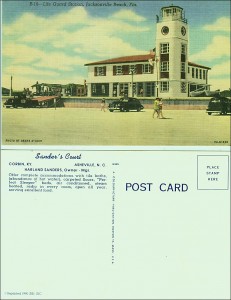
Linen cards aren’t immune from reproduction. Check the backs carefully, note the “heft,” and examine the coloration of the image for fading.
The back side shown here is from a postcard of Sanders Court, the 1930s motel venture by “Colonel” Harland Sanders of Kentucky Fried Chicken fame. The original Court/Café in Corbin, Ky. was demolished in the late 1960s, making this a collectible subject.
Tougher to spot as a repro, the back side looks vintage, including the original Colourpicture publisher’s mark and stock number. But closer examination shows, in 5-point type at the lower left, a note saying “Reprinted 1990.” Like the Jacksonville Beach card, the color saturation of the image and the “heft” were clues.
Other reproductions are almost impossible to illustrate, because they’re so well done. One unscrupulous trick is to literally glue a reproduced image to another postcard – one that truly is vintage, so the back side appears to give it the authenticity of a pre-20 or pre-1908 card. In this way, a forger can turn a worthless common vintage card into a sought-after busy street scene.
It’s easier to unwittingly buy a repro through the Internet because you can’t actually examine and touch the postcard. But even at shows, repros can end up in your bag if you’re going through cards quickly—especially when they’re encased in plastic sleeves, which dull the image slightly and disguise the postcard’s weight.
Reputable dealers will mark cards in their stock as reproduction if they’re aware that they are repros. Sometimes, in their hurry to mark and sleeve a large collection of cards they’ve purchased, they’ll miss one, though. I’ve seen dealers at shows get the opinions of other dealers as to whether a skillful repro is an original or not when they’re in doubt themselves.
The moral of the story? Examine postcards very carefully, front and back. Read all the fine print. Pay attention to the “feel” of the card and the appropriateness of its colors to the era. Make sure the age signs of both sides of the card match each other. If you’re in doubt, ask the dealer to help you examine the postcard more closely.
Bonnie Wilpon, the author of “Postcard History of Sarasota and Bradenton, FL,” and “Postcard History of Hollywood, FL.” (published by Arcadia Books), is a Worthologist who specializes in postcards.
————————————
WorthPoint—Discover Your Hidden Wealth
| Share |

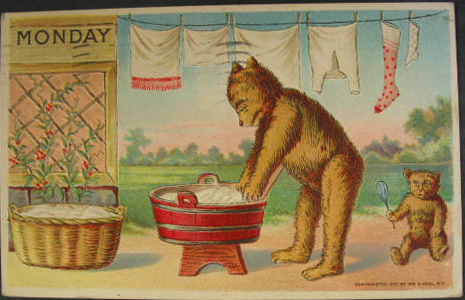
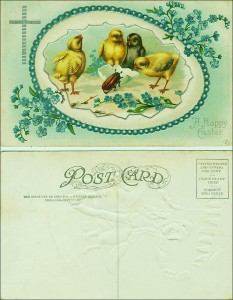
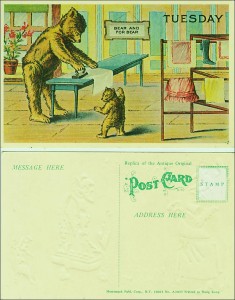
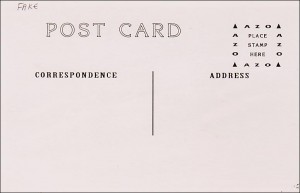
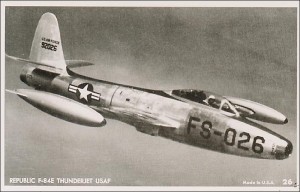
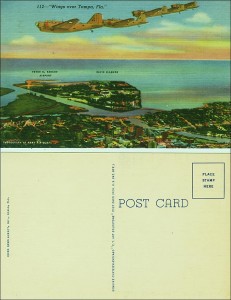
No comments:
Post a Comment